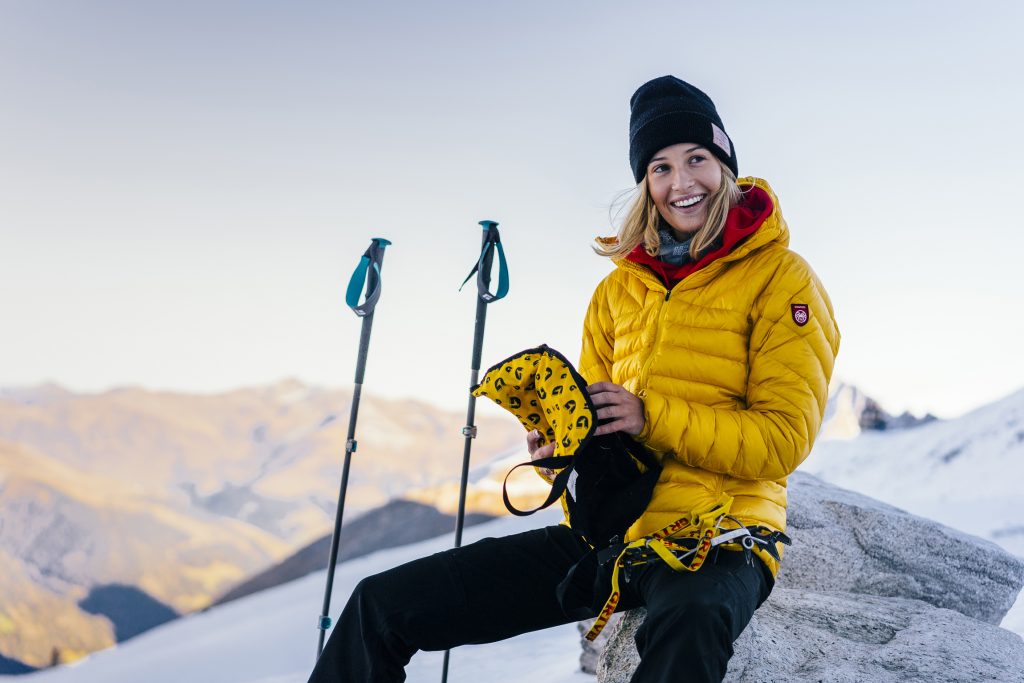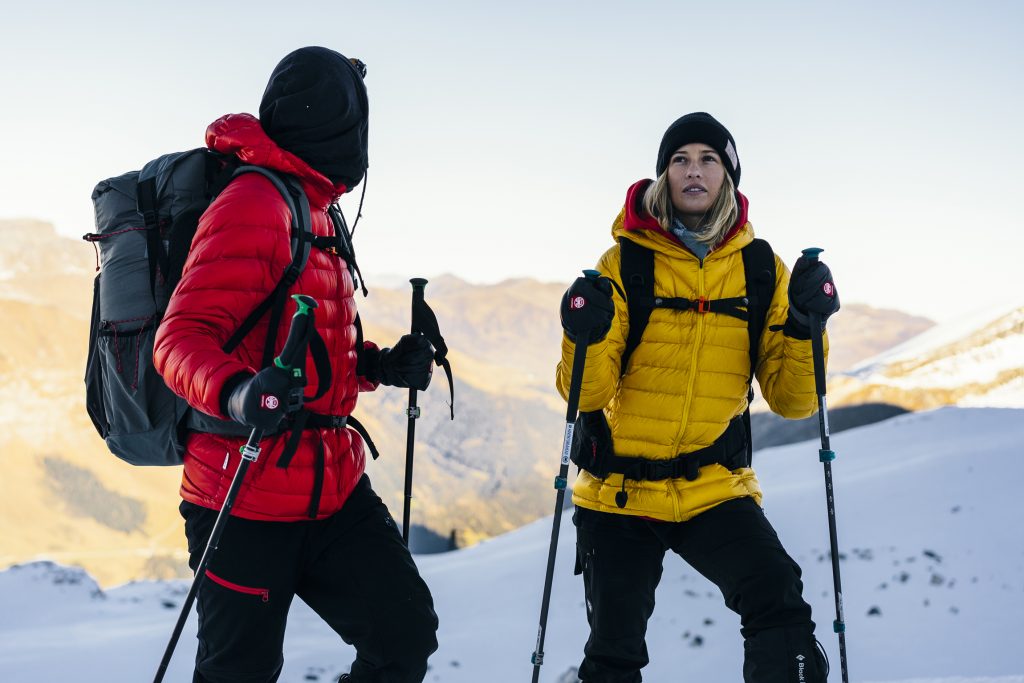
WHAT JACKET TO CHOOSE FOR SKI TOURING?
Ski touring differs from regular skiing in many ways. First and foremost, it's not an option for the lazy! In order to enjoy a thrilling descent, you must first painstakingly ascend to the summit. The reward for your effort is an incredible sense of satisfaction, independence, and, of course, cost savings. However, this means that you need a well-chosen outfit for ski touring, and one of its essential elements is the right jacket.
WHAT WILL YOU LEARN FROM THIS POST?
- What is the best jacket for ski touring?
- What layers should ski touring clothing consist of?
- Can a down jacket be used for skiing?
IN BRIEF
The ski touring outfit should consist of three layers: thermal underwear, a membrane jacket that protects against weather conditions, and the most important layer, the thermal insulation layer - a down jacket or a thick fleece, which provides insulation. It's better to opt for a down jacket as it ensures optimal breathability and thermal comfort! And if you get too hot on the way up, you can simply compress it to the size of a lunchbox and put it in your backpack. This wouldn't be possible with a heavy membrane softshell.
APPROPRIATE CLOTHING FOR SKI TOURING
Just a jacket is not enough to provide comfort during ski touring adventures. The comfort of a ski tourer depends largely on the breathability of their clothing, which, in turn, depends on the interaction between the individual layers. The challenge lies primarily in the fact that ski touring combines downhill skiing, where icy winds blow over your entire body, with uphill climbing. Let's not deceive ourselves: the latter aspect is definitely more demanding and takes significantly more time. Climbing with skis can be truly exhausting and can make you sweat profusely. When you add ever-changing weather and trails that lead through sheltered valleys one moment and exposed ridges the next, you're guaranteed to catch a cold. Of course, if you don't protect yourself properly.
Ski touring clothing must dry quickly and effectively breathe. This task is primarily fulfilled by the thermal underwear, which fits snugly against the skin. It's worth noting that during winter activities, the moisture produced by your body often becomes more of an issue than falling snow. Shirts and leggings made of merino wool or synthetic functional materials can effectively wick away evaporating sweat to the outer layers, preventing the body from cooling down.
The ability to provide additional warmth, which fleece doesn't offer, as well as resistance to soaking and wind, are also important factors. These characteristics should be exhibited by the second and third layers of ski touring clothing. However, weight plays a primary role in their selection. During uphill climbs on skis, every additional gram counts.

Warmth or Waterproofing?
It would seem that there is nothing better for skiing, where you are surrounded by more or less frozen water from all sides, than a membrane hardshell. The higher the degree of waterproofing, the better, right? Unfortunately, that's not entirely true. The membrane, indeed, protects you from external moisture, but its breathability is limited. During intense uphill climbing, your own sweat, condensing under the non-permeable membrane, can become a real problem. Moreover, such a jacket usually weighs quite a bit. And here is where the perfect solution comes into play: the down jacket.
Advantages of a Down Jacket
A good down jacket has the wonderful property of breathing better than any membrane. The natural insulation in down jackets consists of tiny clusters derived from ducks or geese. Nature has endowed these birds with extremely effective protection against cold. The down, located right next to the animals' skin, regulates thermal comfort perfectly, preventing overheating or chilling. It performs the same function in a jacket!
The secret to the effectiveness of down lies not in its quantity, but in its loftiness. Air accumulates between the tiny clusters, and when it is still, it becomes an excellent insulator. The more air there is, the better the insulation against the cold. This characteristic offers two important benefits for ski touring: a down-insulated jacket is incredibly lightweight and can be easily compressed into a very small size. This is crucial because avoiding overheating is essential during ski touring climbs. Otherwise, during the descent, instead of adrenaline, you will only feel unpleasant cold, not to mention that you may end up spending the next week on sick leave. That's why, when climbing up, you will surely decide to take off the jacket and pack it in your backpack.
When it's really cold, a down jacket can also serve as an intermediate layer between thermal underwear and a hardshell. It can successfully replace a fleece. Some models, designed with this in mind, are even called down sweaters rather than jackets.
Is a Down Jacket Suitable for Skiing?
But wait! Someone who has heard some myths might object. After all, down is hygroscopic, which means that a down jacket will immediately become wet when skiing. Indeed, natural down absorbs water, and when wet, it temporarily loses its insulating properties. However, if the jacket is well-constructed, the down will dry quickly under the heat of your body. Experts say that it shouldn't take longer than drinking a cup of latte!
Of course, for those venturing into really wet areas, down jackets with a membrane coating are also available. However, such jackets are better suited as stationary clothing rather than for intense activities.

Choosing a Down Jacket for Ski Touring
PHANTOM ANORAK
What gives the Phantom Anorak an undeniable advantage over other models? First and foremost, its ergonomic design - slightly extended to better protect the lower torso, but without restricting freedom of movement - and its extremely low weight and high-quality 750 cuin Polish Goose down insulation. The cover is made of ultralight TOREX™ Airtastic™ fabric.
The Phantom Anorak is a treat for fans of old-school outdoor style - pulling it over your head evokes the 80s. At the same time, the possibility of unzipping from both sides increases the functionality of the model. Additional advantages include the chest and back pockets, which can hold accessories you want to have at hand. When packed, it takes up the same amount of space as a thermal cup and weighs just a little more than 1/3 of a sugar packet.
If the Phantom Anorak caught your interest, we are confident that you will also love the Phantom Cargo pants - ultralight protection against cold after climbing! These pants filled with 750 FP goose down have a side zipper, allowing you to put them on without taking off your skis, which is an invaluable convenience for ski tourers.
SHADOW VEST
An alternative to a jacket could be a vest. The Shadow vest works great as a warming layer. The classic cut of this lightweight vest, which weighs almost nothing, fits well under a hardshell when needed. The vest is also a great stationary solution - it will warm the most vulnerable areas of your body, located on the core, in a shelter or tent, without restricting your movements in any way. The Shadow vest also comes with a compression sack, so you can easily pack it into your backpack if needed.
Have you chosen your jacket? In that case, prepare additional clothing items: a thin hat, balaclava or headband for under the helmet, at least two pairs of gloves (thinner ones, like softshell, for the approach and insulated ones for the descent), and a multifunctional neck gaiter. Don't forget about ski socks. Enjoy the charms of winter responsibly with a reliable down jacket from pajaksport.pl!
Image source: pajaksport.pl